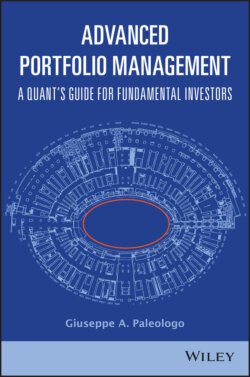Читать книгу Advanced Portfolio Management - Giuseppe A. Paleologo - Страница 13
3.4.1 What Is Risk?
Оглавление“To risk” comes from the Italian verb risicare [Bernstein, 1996], as in the old proverb chi non risica non rosica: “those who don't take risk don't eat”, which illustrates that you don't need to have a PhD to understand the trade-off between risk and return. When it comes to actually defining risk, opinions differ wildly. A deep value investor with little quantitative training may answer that risk is “the possibility of a permanent loss of capital”, which sounds great until you try to determine what “permanent loss of capital” means. A company going bankrupt? Our investors withdrawing their capital from our fund? If our losses are large enough, our fund may be unable to meet its funding obligations. In this case, we would be forced to liquidate part of the portfolio or even to turn our entire portfolio over to our prime broker counterpart, another permanent loss of capital. And over what time horizon? In the long run we are all dead anyway. There is a nugget of truth in this definition, though. Risk is associated to the probability of losses large enough to disrupt our ability to invest. I am assuming you agree that is an acceptable definition of risk. But how to quantify the probability of a large loss? First, we need a probability distribution of losses; second, we need to set a limit on the loss, and our tolerance that it occurs. The first task is much harder than the second. To address it, we must have a good model of asset returns, especially in times of stress. This is not specific to fundamental investors: large financial institutions, like banks or insurers, face the same problem. In their case, a large loss impairs their ability to function or damages their reputation. Their problem is complicated by the fact that their portfolios are made of assets and liability claims that behave very differently from each other. The case of equities, however, is easier for two reasons. The first one is the relative simplicity of a cash security: a fractional ownership contract. The second one is that, if enough care is put into the models, the factor and idiosyncratic returns are sufficiently well-behaved, in the sense that their standard deviations:
1 are finite, as opposed to infinite, which could in principle be the case;
2 can be estimated, as opposed to being nonestimable because they are too noisy;
3 are the only statistics of interest, because higher-order statistics of returns, like skewness and kurtosis, cannot be estimated.3
These facts are mostly true, but far from obvious! Standard deviations are almost surely finite, are not straightforward to estimate, and most likely statistics more complex than the standard deviation are essentially not-estimable. Moreover, it is essential to have an understanding of the properties of returns for investment purposes, and for these reasons this book dedicates a full chapter to the statistical properties of returns. For this chapter's purposes, we take advantage of the fact that there are two quantities of paramount interest: the mean, which measured the centrality of returns, or their center of gravity; and the standard deviation, which measures the dispersion of returns around the mean. In finance, the standard deviation of a stock's returns is also referred to as volatility. You can hear that Wal-Mart has a 1% daily volatility. This means that Wal-Mart's daily returns have a 1% standard deviation.4 With mean and volatility you can estimate losses; for example, we will use these statistics in Chapter 10. Oftentimes, we assume that returns are normally distributed. This is an optimistic assumption, but it provides a useful reference point, in the sense that changes in volatility estimations roughly correspond to changes in losses that could be experienced with a given probability. A loss of minus one standard deviation or more from the expected return occurs with a probability of about 16%. In one year (or 252 trading days), you can expect 40 days with such returns. A loss of minus two standard deviations or more occurs with probability 2.3%. Table 3.3 presents some numerical examples. The volatility of a stock, or of a portfolio, is the yardstick that allows us to measure and compare risk. The daily returns of a single asset are not normally distributed; taking it one step up in mathematical sophistication, they are not even log-normally distributed. However, based on its recent history, you can estimate its volatility reasonably well; and given its volatility, you can formulate a reasonable estimate of extreme losses. For a model of reality to be useful, it is sufficient that it work better than the alternative; certainly for equity returns there are no alternatives to factor models that are obviously better, and risk models do work well to perform a wide range of functions, and in a wide range of market regimes. Where we believe they fall short – and every model falls short! – we'll caution you.
Table 3.3 Probabilities of occurrence of rare events under the normal distribution from “one sigma” event up to “three sigma”.
| std. deviations | Probability (%) | Events/year | Events/five yrs |
|---|---|---|---|
| −1.0 | 15.87 | 40 | 200 |
| −2.0 | 2.28 | 6 | 29 |
| −2.5 | 0.62 | 2 | 8 |
| −3.0 | 0.13 | 0 | 2 |
